Guest Post by: Parineeta Dandekar
At the first sight, Daarche Paani (‘water at the doors’) appears unreal.. on a small flat plateau called ‘Sadaa’ in konkan, an elegant cobbled walkway leads a puzzled visitor to stairs carved in stone, which go down to an ancient grove, and here is an intricate system of tanks, channels and falls which supplies water to the Panderi village and goes down as a free flowing stream, to irrigate a plantation of arecanut, pepper and mangoes in a village called Gudaghe. When I visited the place, I could see three eminent visitors, a silent lady washing her load of clothes, a fairy bluebird splashing at a tank and a huge moonmoth in one of the trees.
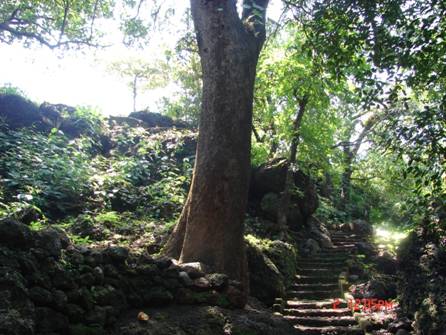 Stone walkway and ancient mango trees leading to Daarche Paani.
Stone walkway and ancient mango trees leading to Daarche Paani.
Photo: Parineeta Dandekar
Lateritic plateaus in konkan act as sponges for water storage, and numerous small community-managed water harvesting systems have evolved here for centuries downhill these plateaus. In keeping with its tag as one of the biodiversity hotspots of the world, this part of the Western Ghats is teeming with rare biodiversity and endemic species. These plateaus are home to rare herbs and plants, a sanctuary to fauna like leopards, civets, pangolins, and a huge store of drinking water, which is rare in konkan, despite the heavy showers it receives. The severe slopes, innate instability of the land and relatively less ‘development’ make this area unfavourable for big dams, and small community led water supply schemes are the lifelines of the region.
Daarche Paani consists of seven tanks, each built in stone at different level. The first tank receives continuous fresh water from an underground spring and is called “Devache Taake” (tank of the gods”). This is generally untouched and is worshipped with locally grown produce every time there is a wedding or a birth in the village. Devache Taake then overflows through a channel to a drinking water tank, from where the women (thankfully, now also men) collect water. Washing and bathing near this tank is not allowed. It is cleaned daily by the first and the last user. Then is the tank for the cattle. This one is bigger, with gently sloping margins. It is very interesting to see these margins, which allow small animals as well as birds to use the tank, without the perennial danger of a thirsty being falling in and drowning. (This is heart-breakingly common in our national parks, where the deep pools constructed by the Forest Department result in deaths of many birds, especially owls). Then are the tanks for cleaning and bathing. These have specially built stone platforms. These tanks then converge into a channel, which flows down and irrigates an areca nut and pepper plantation downstream. Further, this small spring joins the river and meets the Vashishthi estuary, just 2 kms from here.
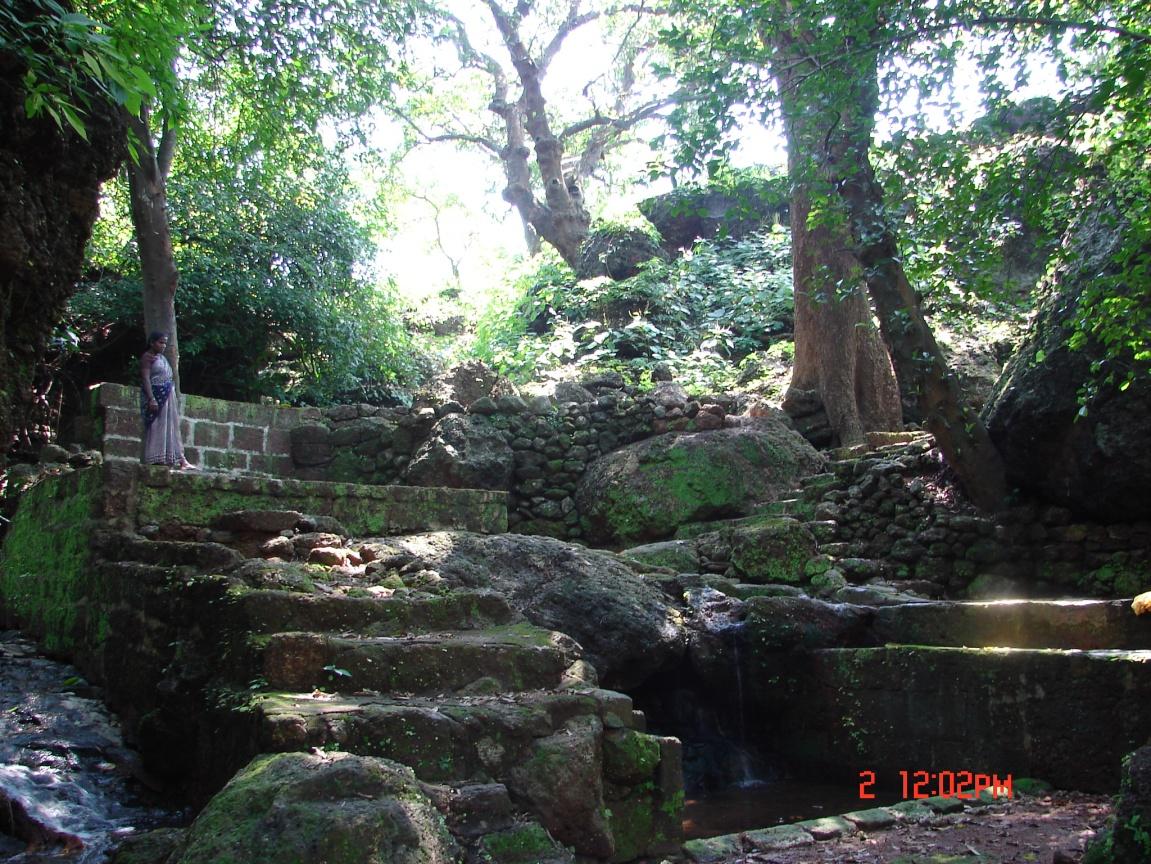 It’s difficult to capture the system in the tangle of trees.
It’s difficult to capture the system in the tangle of trees.
Photo: Parineeta Dandekar
None from the village of Panderi know who actually built the system and when. It supplies water even in the dry months of April and May and what’s more, though a village water supply scheme has reached the Panderi village, people still prefer drinking water from Daarche Paani as it is supposed to taste (and looks) much better and also is more reliable than the scheme. The entire system is located on land owned by one of the plantation owners in the Gudaghe village and once, when he decided to sell the mango trees guarding Daarche Paani to a logging contractor for Rs. 3000, the villagers intervened. They strongly protested against cutting of trees in this region, and when the landowner was adamant, the villagers, most of whom are marginal farmers, actually raised money to pay off the landowner and cancel the deal to protect the trees! Similarly, when the Zilla Parishad declared its intention of building a concrete water tank here and generally ‘cleaning up’ the place, (which entailed cutting the trees) the villagers strongly protested in the Gram Sabha and the plan was cancelled. One cannot blame them when one sees the terrible condition of the jackwells maintained by the Zilla Parishad.
The place is cleaned daily and there are strict rules to be followed, which are hand painted on a board, which says: “Cutting of trees, littering, bathing in upper tanks and eating tiffins in Daarche Paani is not allowed”. And these rules are adhered to quiet strictly.
The system which supplies water to a population of more than 300 throughout the year and flows down to irrigate a 5 hectare plantation in a different village, is completely maintained by the villagers. In the summer months, they complete any repairs needed. Funds are raised from the village and shramadan is a way of life.
Similar systems, though on a smaller scale are seen in all neighbouring waadis, where the water coming from the Sadaa is harvested through tanks and channels built by the waadi. Though Zilla Parishad Water schemes and hand pumps have reached some of these waadis, (which is note worthy, looking at the remote location) they are not reliable and the villagers rely heavily on the traditional systems. All water for drinking is collected from these systems only. When cyclone Phyan hit this region in November 2009, water supply was totally disrupted for more than 18 days and the population was entirely dependent of these community systems and individual wells.
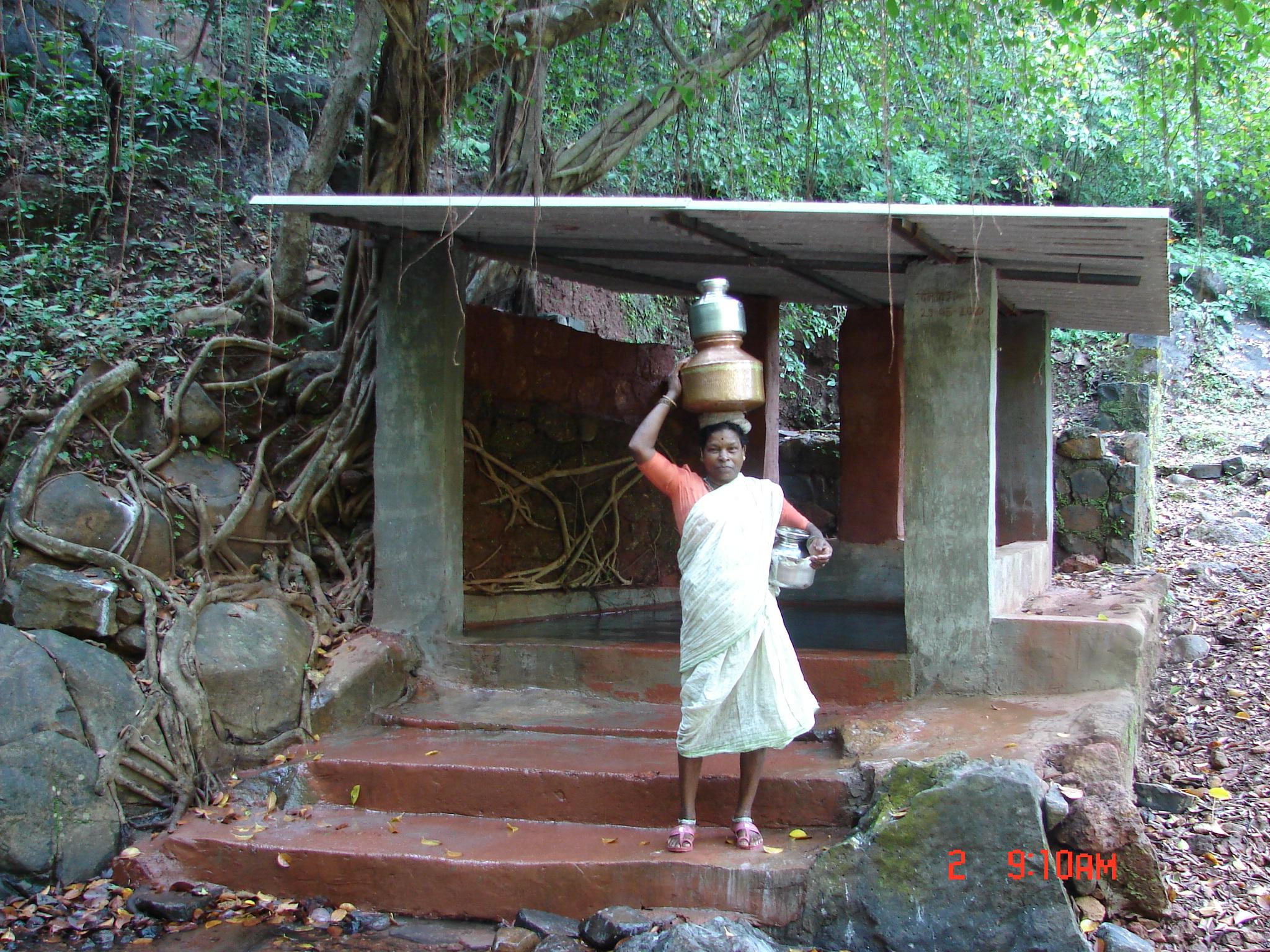 A spring tank built by the villagers at Temkar Waadi. Civets and leopards are regular nocturnal visitors to these tanks.
A spring tank built by the villagers at Temkar Waadi. Civets and leopards are regular nocturnal visitors to these tanks.
Photo: Parineeta Dandekar
The above spring tank is built at Temkar Waadi, it is a 4 kilometers trek from Daarche Paani. The waadi is situated just below the ridge of the mountain range and is a one hour climb from the main road. When I asked the villagers about the financing of these schemes, they seemed puzzled, it seemed natural for them to build and maintain such systems, without expecting help from any government schemes or projects.
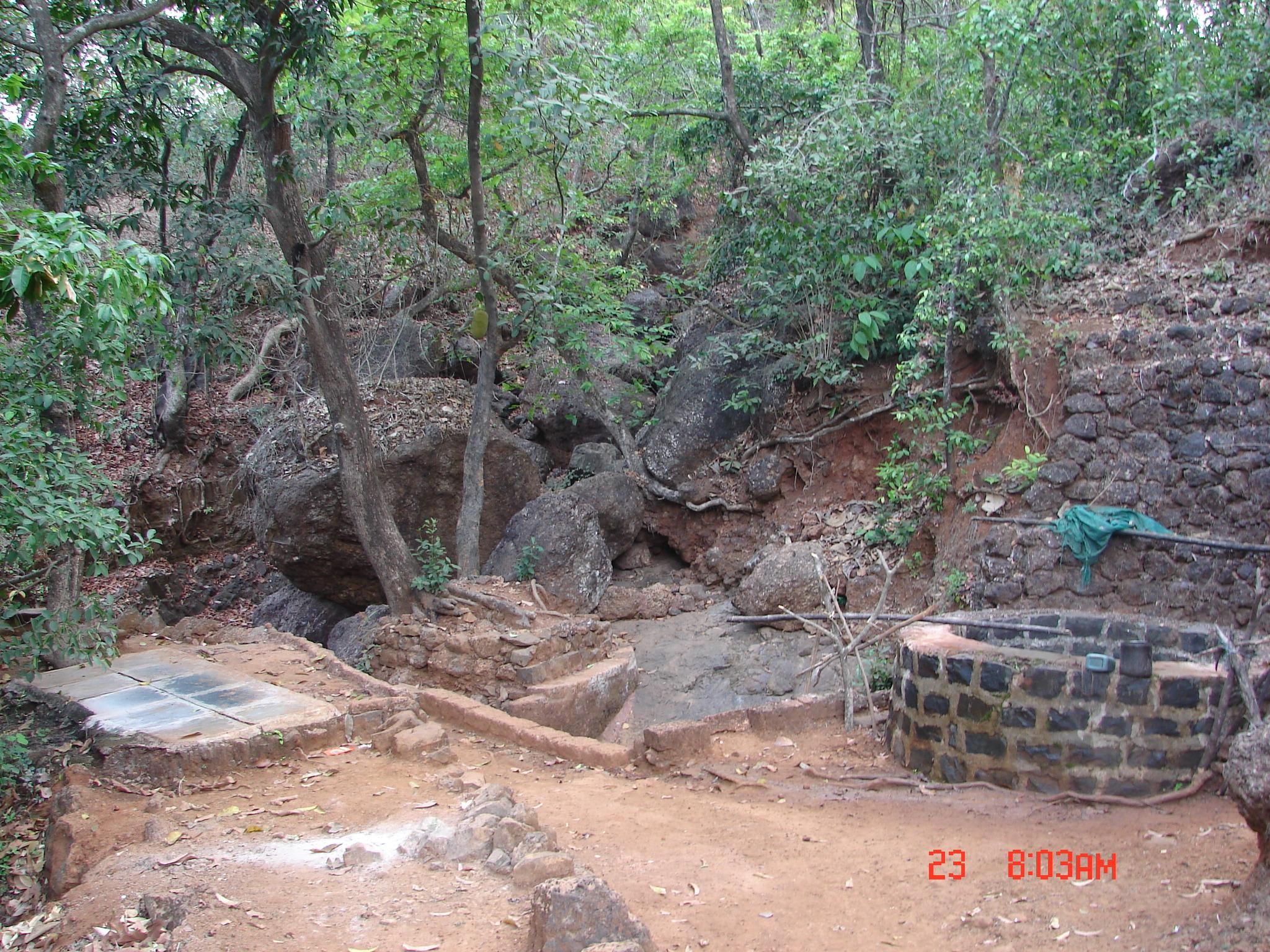 A springwater collection system at Kolhe Waadi in summer. The shallow well contains clean drinking water.
A springwater collection system at Kolhe Waadi in summer. The shallow well contains clean drinking water.
Photo: Parineeta Dandekar
A remarkable system has evolved at a neighbouring village of ‘Derde’. Derde, situated next to the Vashishthi Estuary, on the top of a mountain, is hidden in Forests and mango plantations. Its forests boast of twenty-strong hornbill flocks and its huge trees have been the nesting ground of various eagles for many years. Much of this is changing, with the entry of shipyards near its foot, which have destroyed an entire mountain and has destructed hectares of mangrove forests.
Derde had a perennial spring running through it, which supplied water till the months of April. April, May and June are the most difficult months in Konkan due to paucity of water. 40 years back, a group of ambitious youth from Derde built a small spring tank at the base of a spring and protected its source. They did not only develop a hardware system, but a system of rules for using this tank. The village contributed to the construction of the tank and people who could afford, took individual water connections from the tank to their homes. Those who could not afford individual connections had to come to the tank to fetch water. This task was divided between men and women. In the summer months, piped water was stopped and everyone had to come to the tank for collecting drinking water and washing/ bathing, to avoid wastage. If water scarcity became severe, only drinking water was to be collected from the tank and the women ( only them this time!) went to the nearby river for washing. The system works the same way even today.
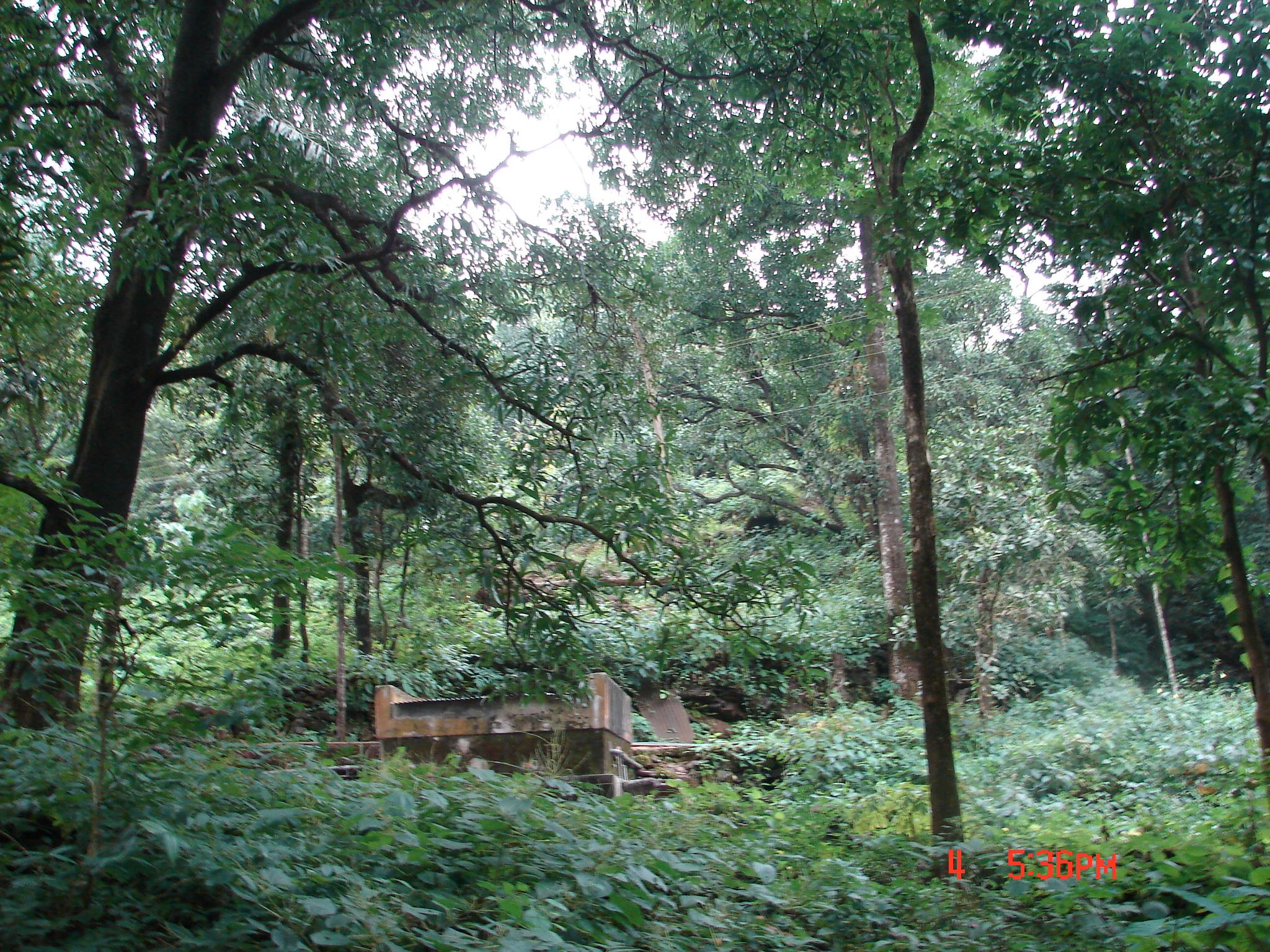 Spring tank at Derde, hidden in the forest. Photo: Parineeta Dandekar
Spring tank at Derde, hidden in the forest. Photo: Parineeta Dandekar
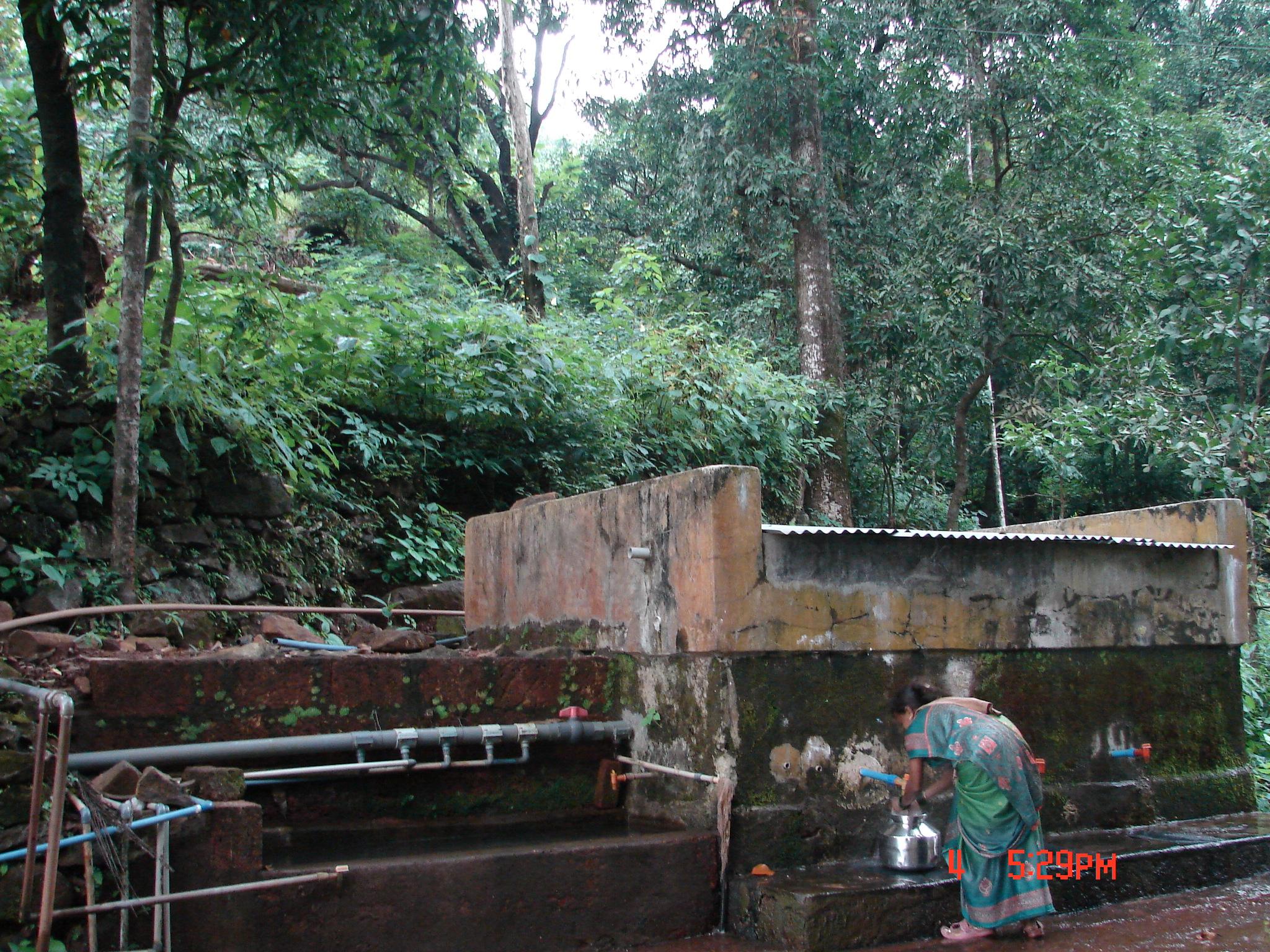
Spring tank with individual water connections. Photo: Parineeta Dandekar
These systems may not be as grand and decorative as the ones in Gujarat or Rajasthan, but while most of the bigger systems are now facing disuse and neglect, these systems are still functioning are being maintained and managed by the community. These are not just tanks and channels, but a part of an intricate system, with its own code of conduct and negotiating mechanisms. Most of these systems provide water not only to humans, but also to animals and birds, many of which are rare, endangered and endemic to Western Ghats, and all this is many times cheaper, more efficient and ecologically benign than conventional dams and canals approach.
While, the intention is not to eulogise these systems which are extremely case-specific, one thing is certain, these system have evolved with the society and respond to their needs and requirements perfectly. Any hasty attempt to ‘revamp’ or upgrade these systems can result in more harm than good. Already, the systems and the entire water sovereignty (at least drinking water) of the region is jeopardised due to the proposed string of power plants in Konkan region. Gudaghe-Panderi village is proposed to have a 1200 MW combined cycle gas based power plant , situated right on the plateau, which is the biggest natural water harvesting structure of the area. Derde village is witnessing huge forest cutting and ecological destruction with the onslaught of Shipyards and mining in the region.
Unfortunately, these find no mention in either the super fast EIAs being performed in the region or scientific documentation. It is high time we pay heed and due respect to these small, appropriate and beautiful systems which provide invaluable services to humans and non humans without causing displacement, environmental destruction or moral and material corruption.
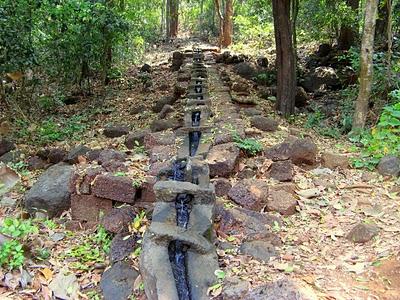 Small spring supplying water to the temple tank in Asud, Dapoli.
Small spring supplying water to the temple tank in Asud, Dapoli.
Photo: With thanks from meghaclicks.blogspot.com













